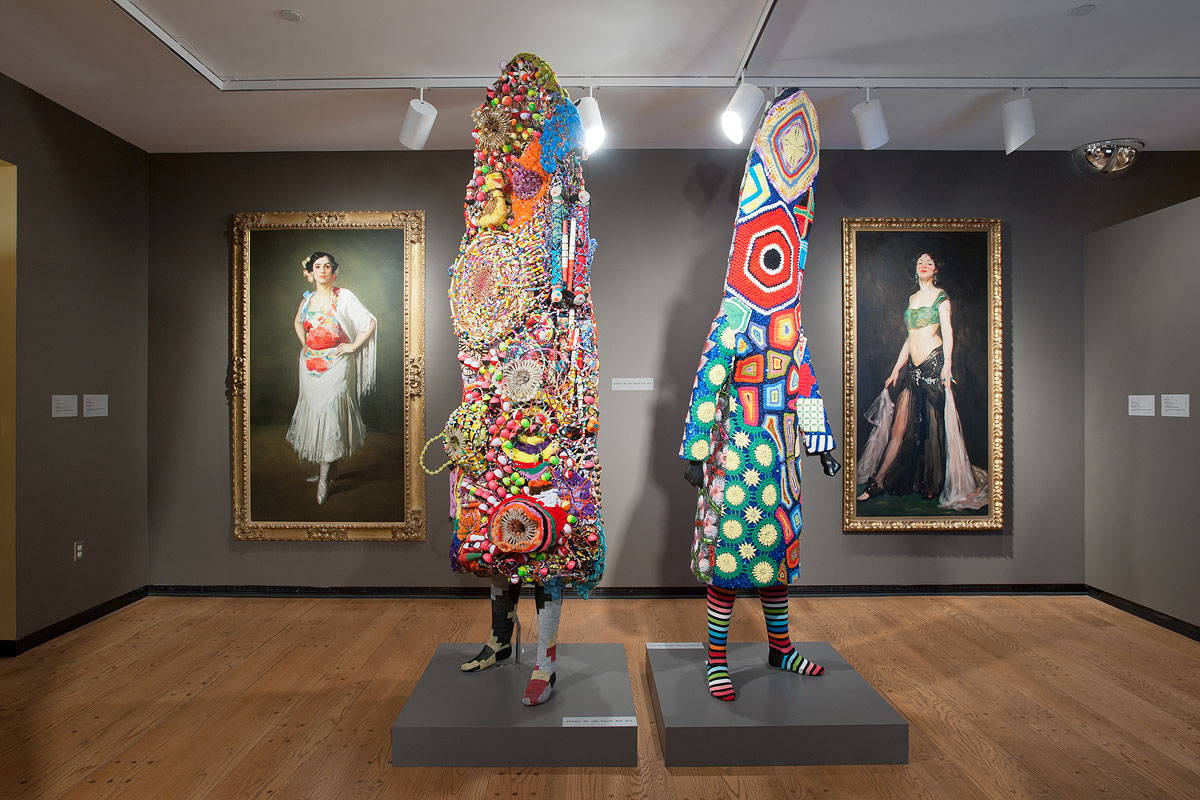

Currently on display in the Bassett Gallery of the Mead Art Museum until July 3, 2012, the temporary exhibition, “Exotic Muses: Dancers by Robert Henri and Nick Cave” has been captivating visitors. The six-object installation features three paintings by American painter Robert Henri and three “Soundsuit” costumes by contemporary sculptor and performance artist, Nick Cave. Although the two artists’ works differ vastly in style and media, they are underpinned by the common theme of displaying the dancer’s body as a means of personal and cultural expression. The title of the exhibition refers to how Henri and Cave’s works represent the dancers as exotic “Others.”
Robert Henri (1865-1929) rejected Academic and Impressionist painting in favor of a more immediate style of realism, which he developed as a leader of the so-called “Ashcan” school. Henri was fascinated by Spain and he traveled to Madrid several times, where he copied the work of Diego Velazquez. Henri integrated Velazquez’s direct painterly techniques into his style and exclusively-painted subjects that held emotional and personal appeal. Salome Dancer is an important piece from the Mead’s own collection, while “La Reina Mora” is on loan from Colby College and Spanish Dancer with Cigarette is on loan from a private collection. Although Henri’s paintings lack shock value when juxtaposed with Cave’s “Soundsuits,” both artists were correspondingly radical in breaking with the conventions of the art establishment and challenging the boundaries of their practice a century apart. Cave was inspired to construct his first “Soundsuit” when, in a forlorn moment of contemplating the Rodney King beatings, he saw a pile of twigs that looked forsaken. Cave gathered up them up by the armful and created a mobile sculpture that made rustling sounds upon movement and could be worn as a second skin.
“Spanish Dancer with Cigarette” simultaneously conforms to the Carmen stereotype of Spanish women that dominated the time period and subverted traditional notions of Spanish womanhood. In an effort to reaffirm national identity, local artists, writers and performers glorified stereotypical Spanish and Andalucian culture. Henri exemplifies this tradition with the Andalucian hat and the carnation that constitute folklore costuming, yet the object of the cigarette, emphasized in the title of the painting, gives the painting a scandalous sense of modernity. “La Reina Mora” means “The Moorish Queen,” which was a stage name of a famous Andalucian dancer named Milagros Moreno. The painting resembles posters of female stars of theater performances in Madrid. Moreno commands the viewer’s attention in a bold pose with her hands on her hips and one leg thrust forward, characteristic of the beginning of a Flamenco performance. The provocative pose of the subject of “Salome Dancer” invites the viewer to admire her body, yet her upturned chin and contemptuous expression gives a repelling impression of haughtiness. This painting bears no direct reference to the biblical story and instead creates the playframe of a model posing as a dancer performing the story of Salome in the world of vaudeville.
Cave’s “Soundsuits” collapse the distance between art and everyday life by serving the dual functions of costumes and sculptures and integrating common, mass-produced materials into intricate, handmade works. They derive influence from African concepts and utilize colors, fabrics and found objects that are similar to the materials used by the Yoraba people in their ceremonial costumes, called egunguns. The Yoraba’s egunguns metaphorically embody the contact between the living members of the community and their dead ancestors. Cave’s “Soundsuits” combine old and new, natural and artificial and foreign and familiar materials into elaborate performance pieces that exhibit human connections to one another, the material world, and the past. Although the “Soundsuits” are androgynous, their phallic shape and monumental size create a sense of masculinity that contrasts with the feminine subjects of Henri’s paintings. One of the “Soundsuits” resembles a cross between Gumby and a monster from Where the Wild Things Are. A second, heavily bedazzled one, intricately weaves the reflective surfaces of beads, mirrors and sequins into a knit structure. The most overwhelming one utilizes unorthodox materials like fishing bobbers, straw baskets, pipe cleaners and plush animals into a net of material exuberance. The incorporation of commercial, mass-produced object into the very traditional and personal process of knitting creates a striking duality that provokes the viewer to think about the relationship between modernity and culture.
Nick Cave will visit Amherst on Friday, April 27 for a public conversation at Stirns Auditorium, followed by a reception at the Mead.
Informative article, exactly what I was looking for.
Also visit my blog post: webpage (Roxanne)
539 for the iPhone 6, as well as from?
Visit my blog post free apple iphone 6 verizon